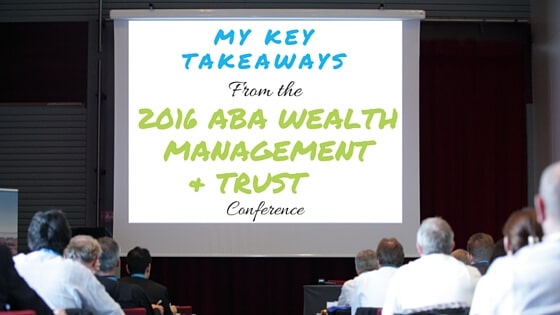By R. Steuart Bruce, Principal, Banking & Financial Services
The American Bankers Association holds an exceptional annual Wealth Management and Trust Conference where thousands of people in the wealth management and trust industry discuss challenges, learn about new technology, share ideas and network with each other. I went to this year’s conference which was well-attended by both large and small organizations and incredibly well-run. Thank you ABA for another insightful trip!
I learned a lot during the week, but three concepts really stuck out to me:
“The Industry is Overdue for a Disruption”
An industry expert at the conference said the above quote, and he is so right. Wealth management and trust organizations are not often quick to change with the times, so as technology advances and they remain stationary, disruptions are bound to happen.
A current disruption is “robo-advisors.” Robo-advisors are automated computer algorithms that allocate, deploy and rebalance investments without the need for any human interaction. Younger, tech-savvy consumers find the low fees, a watchful HAL 9000 eye and Spock-like objectivity attractive. Traditional wealth and trust organizations need to learn how to adapt with changing times and technologies to attract lifelong customers.
Master the Art of Planning
As interest rates lowered, banks purchased and/or grew their wealth practices. However, now newer and smaller competitors are pulling ahead-especially Registered Investment Advisor (RIA) organizations. Banks only have 7% of the market share, while RIAs have a 28% share. It also doesn’t help that Managed Trusts are not growing (Managed Trust CAGR -0.73%/Non-Managed Trust CAGR 1.01%). To remain relevant, banks need innovative approaches and alternative fees.
One of the major value-added differences that traditional banks have is a holistic planning model. They use this model across all investments, not just the ones under management. Software companies are starting to offer “aggregation” capabilities, which is when the advisor can view all of the client’s holdings, regardless of where they are in the process. This is a key differentiator for traditional institutions because they can provide a comprehensive plan, rather than an account-by-account plan.
Several conferences speakers also talked about the actual versus perceived value of a plan. These plans are often free or “included in the fees” for a client. Progressive institutions recommend charging for the plan. The reason for this fee is two-fold: it can increase the fees for the advisor, and more importantly, it engages the client and enables them to be more forthcoming with accurate information.
“Correction Market” Means Low Returns in 2016
Another overwhelming topic of conversation was on what returns will look like in 2016. The general consensus at the conference was that returns will be flat or increase slightly. As we are still in a correction market, commodities will stay low. This brings two challenges to an advisor: First, they must learn how to mitigate panic-stricken clients that want to sell when the market starts to go down, rather than have faith in the plan. Second, they need to develop valuable client relationships to prevent losing clients to cheaper alternatives.
Even though wealth management and trust businesses are competing in an era of disruption, the ABA Conference really empowered me and other business leaders by providing knowledge and innovative practices.
Visit the ABA Conferences webpage to learn about upcoming events.

